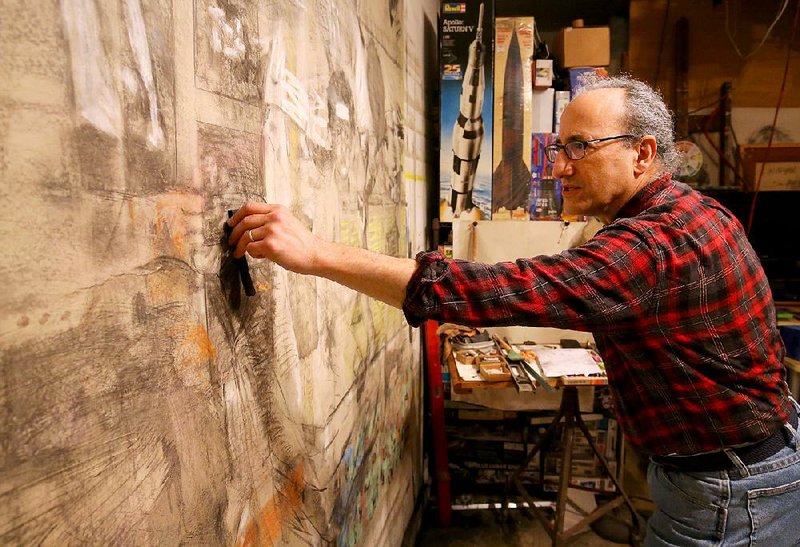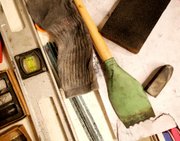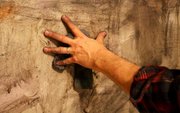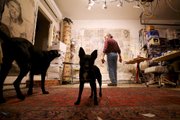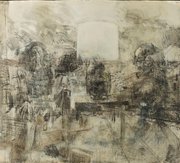You have to begin to lose your memory, if only in bits and pieces, to realize that memory is what makes our lives.
-- Luis Bunuel, Spanish filmmaker
David Bailin: “The Erasings”
Saturday through May 27, Boswell Mourot Fine Art, 5815 Kavanaugh Blvd., Little Rock
Reception: 6-9 p.m. Saturday, artist talk at 7.
Gallery hours: 11 a.m.-6 p.m. Tuesday-Friday, 11 a.m.-3 p.m. Saturday
Info: (501) 664-0030
I f, as Luis Bunuel said, "memory is what makes our lives," Alzheimer's disease unmakes them.
Little Rock artist David Bailin sees this unmaking firsthand in the life of his father, who was diagnosed with Alzheimer's in 2013.
"Memory gives us continuity within life," Bailin says. "How do we keep a grasp on who we are as a person when we lose that continuity in bits and pieces ... then who are we?"
The question hangs in the air, as the artist sits quietly at the breakfast table in his west Little Rock home. One of his daughter's dogs, which he's taking care of, nudges him, wanting some attention. He strokes the dog's head, takes a deep breath and continues.
"I was fascinated by what my father must be going through, trying to figure out who he is with a memory that only lasts maybe 10 to 15 minutes. I wanted to understand it, to investigate this."
In his artist statement about his current drawing series, "The Erasing," Bailin, 62, writes: "As an artist witnessing the shattering of my father's personhood through the shattering of his memory, the question is how to convey this devastating personal, human experience without relying on visual cliches."
The answer to that question is revealed in the creative process of the artworks of "The Erasing": draw, erase part of the drawing, repeat, repeat, repeat.
LAMP, a 79-by-84-inch charcoal, pastel and coffee drawing on prepared paper, reveals a heart-wrenching scene. Through his father's eyes, we see fragments of different memories of people and places commingle, try to intersect, then compete for attention in a near chaotic, frantic cacophony. He tries to remember a life's story, but it is slipping away, scattering like autumn leaves in the wind, blown out of reach. There seems to be no way to collect the thoughts into a coherence; they fragment, dissipate or go crosswire to one another. The viewer is left empty, alone, bereft.
Erased.
LAMP was one of two works from the series accepted in last year's "Delta Exhibition" at the Arkansas Arts Center in Little Rock. It was selected by juror Elizabeth Garvey of Garvey/Simon gallery in New York for one of the two Delta Awards. Several works from the series will be shown at an exhibit titled "The Erasings," which opens Saturday at Boswell Mourot Fine Art in Little Rock.
Bailin is in the "Delta" again this year with another work from "The Erasing" titled Halloween. He has been phenomenally successful in this exhibition. He has won the exhibition's top prize, The Grand Award, three times, the Delta Award four times and has been selected for the exhibit 14 times.
"Each year it's a different juror and I'm surprised I do so well," he says. The juror of the 1999 "Delta," Koplin Del Rio, offered Bailin representation in his gallery in Los Angeles. "They wanted smaller works, so I said no." Two years later, the gallery called again. "I said 'great,' because I wasn't stupid anymore. I just had to figure how to go from [drawing] 8 by 15 feet to 30 by 26 inches."
Bailin still is represented by the gallery, which has since moved to Seattle. He also has gallery representation in Boston and signed with Boswell Mourot last year.
. . .
A native of Sioux Falls, S.D., Bailin grew up one of three children in a traditional Jewish family. His father, Marvin, was a lawyer; his mother, Janet, a speech therapist who grew up in Queens, N.Y. "She was very artistic-minded," Bailin says. His parents were supportive of their son's artistic talent.
"I had a very happy childhood. I wanted to be a famous Jewish artist. The only Jewish artist I knew about then was Marc Chagall and I thought his work wasn't that interesting. I find that funny to be thinking about now."
After college, Bailin spent a decade in New York, starting in the late '70s. He became a performance artist and writer who also produced and directed his creations. "I didn't pursue painting then because the art scene was all about conceptual art and there was no room for stories [narrative art]. So I turned to theater."
While working in theater, he met his wife, Amy Stewart. She finished law school while he worked as a part-time bookkeeper and resumed making art.
The couple moved to Little Rock in 1986 when she accepted a clerk's position with U.S. District Judge G. Thomas Eisele. Stewart is a lawyer with the Rose Law Firm. She and Bailin have been married 34 years and are the parents of five daughters ranging in age from 23 to 29, including a set of twins.
"My requirement for moving was that there had to be a Popeyes chicken outlet," he says. "There was one in Little Rock and that sealed the deal."
Bailin, who had applied for a bookkeeping job at the Arkansas Arts Center, was hired by the late executive director Townsend Wolfe to be the director of the museum school. Bailin stayed for a decade. He also has taught at Hendrix College in Conway and the University of Arkansas at Little Rock, and is currently teaching drawing and art appreciation at the University of Central Arkansas in Conway.
. . .
Over the past nearly three decades, Bailin's work has evolved and shifted. His experience of working in an office cubicle in New York inspired the "C Series"; the angst of suburbia dominates "Dreams and Disasters"; a series of satirical skull paintings became "The Last" (including one titled The Last Artist); and, starting in 2015, "The Erasing."
Bailin's work feels drawn from the dreams and disappointments of Everyman, one often battered by unnamed forces, from the searing and unsettling Slippage and other works in "Dreams and Disasters" to biblical-inspired works and others that reflect and amplify personal and cultural mythology and fears. "C Series" rivets with its unblinking look at a paranoid corporate life. But closer inspection of Bailin's work reveals occasional absurdity and humor amid tilted skylines and swirling energy. The use of coffee (a wry reference to office culture) also adds a warmth to his drawings, which contrasts with the grittiness of the works' surfaces.
The idea for an Alzheimer's series began with a discussion of a collaborative multimedia performance with sculptor Holly Laws over lunch in 2014 at UCA, where she also teaches.
"Her father was also going through this," Bailin says. "We were going to record our fathers talking about their lives and use that as the basis of my drawings for the project." The ambitious project is still under discussion, but their initial conversation got Bailin thinking about ways to draw the memories, and set him on his new path.
"In thinking about my father's situation, I began to investigate my own history and discovered photographs I had taken of drawings I had destroyed. I began to realize how powerful it was to draw, then erase part of it. Then draw over it and erase some more."
Through this process of drawing and erasing, he layered scenes from his family's life, mirroring his father's memories as fragmented by Alzheimer's. That was the beginning of "The Erasing."
Bailin had found a way to understand what his father was going through.
. . .
"How do you render the kind of frenetic process my father goes through, that anyone with this disease goes through?"
To illustrate his point, Bailin strides into his studio, in the home's converted two-car garage. The studio is spacious, but unlike many artists' studios, it has no windows. Bailin likes it that way. A chair near the door was a favorite resting place for his late dog, a black Labrador retriever named Kafka. Two walls hold works in progress, two pieces that are each about 7 feet wide. Tables and shelves hold an assortment of supplies and tools -- pieces of charcoal, brushes, a well-worn sock covered in charcoal, a jar of coffee, pastels, colored pencils and a clay tool and stencils used to add texture and patterns. On one shelf are NASA model kits, yet to be opened.
"It's like this drawing on the wall," he says, pointing to an elegant work he calls The Three Graces. It depicts his mother, grandmother and aunt, and it radiates familial love. It is the foundation for the next work in "The Erasing."
"I love that drawing," Bailin says, his arms crossed. "I would love to have it." But it too will be at least partially erased. One can sense some pain and maybe even dread in his voice as he ponders that inevitability. Walking over to another work in progress, he picks up a rag and wipes across part of the image, blurring the lines between two drawings.
"By erasing parts of a drawing, it puts me into the frustration and anxiety my father must be going through. It wouldn't work if I draw something I didn't care about and then erase it. I wouldn't feel anything. I'm not drawing from a third-person perspective; I'm in it as a method actor. While I'm drawing and erasing and drawing again, I'm feeling it as the person who is experiencing it. I'm in that drawing when I'm working."
The Three Graces and other drawings won't be completely lost -- Bailin photographs each step in the creation of a work.
Family photographs spark his father's memory, Bailin says. "They are models for my work, the basis of moments that do return."
"The process usually goes from seeing a photo of my mother or father, the place we lived, family, maybe their friends. Each drawing produces another reference; I'll make a sketch, but a residual memory comes in. In LAMP, for example, there is a diagram of the house where I lived growing up that's there as a reference. The marks I make in the drawing are similar to the memory process; marks can represent inside or outside of objects, be a tonal reference, background or foreground.
"Every step there is a decision ... what is my father seeing? He sees stuff, but may not recognize what it means or his position in it. I begin with The Three Graces as a set point. I don't know the effect of the erasing until I do it. There is a reaction to the drawing that will move it forward. I photograph the drawings at each stage of the process so I can let them go.
"The next drawing determines a lot about what will be kept. I'm working with lines and flat areas, so a lot of stuff will come through as a result. If I need to articulate a shoulder, anything behind it will fade or disappear. The real impact comes in the next drawing. Change is the result of the next information."
What happens if he makes a mistake?
"If I have an 'oops' moment, just as my father goes back to a point over and over, I can go back and redraw. This is adding to the memory or the depth of the feeling; it mirrors randomness of the disease itself."
At first glance, one might think Bailin's work is abstract art.
"Everything in these works has a realistic basis. I'm a conceptual artist, I work it out in my head."
Bailin says creating the work, at its best, is a struggle.
"My father is losing something that has real meaning to him; I have to do it this way. I don't want the drawing to come as an easy thing, I want it to fight me ... is it saying what I want it to say, is it evolving in a way that confronts me?"
And when it's done?
"There is a catharsis," he says. "I can see it when it's finished ... when it says what I think it needs to say. There is an equilibrium between what is drawn and what is left; what is implicit and what is implied."
. . .
A sense of melancholy lingers in the finished art.
While the subject and its autobiographical nature lend a certain gravitas, Bailin says there is a bit of levity in each work.
"There's something really joyous about this series as well. As I draw, I'm remembering. I had a wonderful childhood, these photos reinforce that and the drawings are created from the memories.
"What is sad is my father no longer has those memories."
In creating this body of work, Bailin says he has a renewed appreciation for his father.
"He's a fundamentally good, gentle person. In his dementia, he remembers people. He says hello. I can see him as an individual persona and his real character is really lovely."
Bailin hasn't decided whether he will show any of "The Erasing" art to his father, who lives in an assisted living facility in Des Moines, Iowa, near Bailin's brother. Their mother died in 1996. He visits with his father by telephone, usually daily, and travels to Iowa about once a month for several days. During their visits, they look at photographs and talk.
"When he is lucid, he knows he's lost something. And when he's not, why confuse him?"
Has working on the drawings raised his fears of the disease?
"My grandmother on mother's side of the family also had Alzheimer's," Bailin says. "Maybe my grandfather on my father's side, too. So, yeah, it haunts me.
"But how can I best express my own anxiety about it?"
The answer may come in the final drawing of "The Erasing."
"I have a very clear idea of what the final piece of this series will be," Bailin says. "It will have been erased to the point there's almost nothing there ... just the bare elements of something, not even a recognizable image."
Bailin's friends and fellow artists Sammy Peters and Warren Criswell have had long conversations about "The Erasing" and its ending.
"I'm afraid of this one ... Sammy and Warren and I have talked about this being the disappearing artist. I'm in this series conceptually and physically. My work [over the years] as it goes from the constricted cubicle series to outdoors to the brain to the mind is basically removing myself from the art. I am also viewing my own artistic death with this series.
"It's terrifying for me."
On the web:
bailinstudio.com
Style on 05/07/2017
